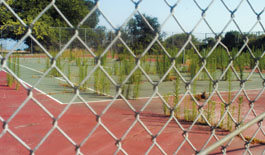home | metro santa cruz index | features | santa cruz | feature story

Photograph by Curtis Cartier
Nature Serves Last : Pogonip is slowly reverting to its original state as native and nonnative species take over man-made structures.
Open Space Invaders
It looks peaceful enough at Pogonip, but as writer Camila Perez learns, indigenous species and newcomers are in pitched battle.
By Camila Perez
Avisit to the Pogonip Clubhouse evokes images of affluent golfers and polo players enjoying drinks by the (now filled-in) pool, while laughter and voices float down from the (now boarded-up) windows of the club. Throughout the '20s, '30s and '40s, this was a gathering place for movie stars and athletes. At present, however, Pogonip is an example of nature taking back what is hers.
It is a beautiful, sunny July day. A group of six or seven people stands in the shade of an old redwood and listens to our guide, Kevin Browning, explain what this place once looked like. Weeds now poke through cracks in the tennis courts, and the gently rolling meadows, which were once converted into an 18-hole golf course, now riot with grasses and wild oats. The landscape is a strange juxtaposition of things that belong and things that do not.
Sometimes telling the difference is easy--for example, the rectangular cement pools, built along the natural flow of the springs in the forest to trap the water, which now house golden koi. Other times, however, invaders are harder to spot. Browning points out Himalaya berry brambles and yellow plum trees, that, despite looking right at home and providing food for coyotes and other animals, are nonnative and invasive plants. The wild oats in the fields do not, in fact, belong there.
Pogonip is part of the city's greenbelt, a secluded and rather unrecognized stretch of habitat located remarkably close to downtown Santa Cruz. Over the past 150 years the landscape has been altered by human influence, beginning with the purchase of the land by Henry Cowell, who introduced logging and the lime industry, and ending in the 1980s with the city of Santa Cruz's acquisition of its scenic 640 acres.
Now, through the efforts of naturalists like Browning and various natural preservation efforts, the park is slowly but surely returning to its old state. According to Susan Harris, associate planner at the Parks and Recreation Department, the city has launched restoration projects, mostly in the sensitive meadow areas, to help clear out invasive species. Park employees remove thistles by hand and mow parts of the meadows, and goats are set to graze and help reduce the amount of "thatch"--the dry, yellow, nonnative grasses--that chokes out the native coastal prairie habitat.
One hundred and fifty years of history lie quietly preserved within the park. Browning leads free nature hikes along the trails, telling the stories of the various remnants of buildings and industry that dot the landscape, as well as information about the plants and animals that call the place home. California bay trees, redwoods and live oak pepper the landscape, as well as California poppies in the fields and ferns by the creek. Browning points out edible plants such as yerba buena, which smells and tastes like mint, but he does not encourage harvesting, as this would have a negative impact on preservation. He does admit to having munched on the local vinegar ant, testifying that "they actually taste exactly like vinegar." Larger fauna inhabit this place as well; our group spots a coyote on the way up to the clubhouse, and bobcats and mountain lions prowl the area.
Trails wind throughout the park and vary in difficulty and in the vistas they provide--you may be deep in the redwood forest one moment and emerge in a sunny field the next. My particular group doesn't even need to squint to see downtown Santa Cruz from the meadow trail: the white church steeple rises above the other buildings, marking the spot.
It's obvious to the visitor why Pogonip was often chosen as a site for vacation homes, and the foundations of some still remain. A knowledgeable member of our hiking group guides us to the location of the back garden of the McCormick vacation home, hidden far behind the fenced-in remains of the house's pool. Invasive eucalyptus close in on that part of the Brayshaw trail, another one of the plants that will have to eventually be removed if native species of tree are to survive.
As our little group approaches the main road and our hike draws to a close, I reflect on some of the things Browning has told us. The best way to see the park, in his opinion, is to come alone, take a silent walk and just look at and listen to all the natural beauty Pogonip has to offer. Pogonip is like a time capsule, buried and forgotten in Santa Cruz's back yard. Browning has grown to love it, and the walks he will be leading throughout the rest of the summer will cause anyone to feel the same.
FREE GUIDED HIKES through Pogonip happen every Saturday and Sunday at 10am (meet at Friendship Garden in Harvey West Park for easy hike) and 1:30pm (meet at Golf Club Drive entrance for more difficult hike) through September. 831.420.5270.
Send a letter to the editor about this story.
|
|
|
|
|
|